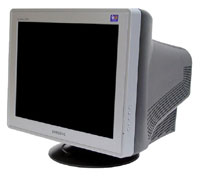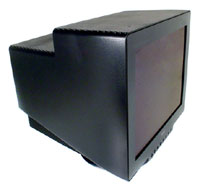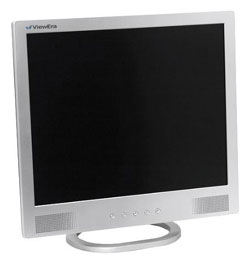Buyer's Guide - Mid-Range, January 2005
by Jarred Walton on January 21, 2005 11:09 AM EST- Posted in
- Guides
Display Recommendations
For a mid-range computer, there are two standard recommendations for the display. The first is to go with a 19" CRT, which will offer a good sized screen at a reasonable cost. LCDs remain a more expensive alternative, with 17" models being the preferred mid-range size. Cheaper 19" LCDs only cost a bit more than the quality 17" LCDs, but we would steer clear of most inexpensive LCDs, as they are often two- or three-year-old screens that are being sold at clearance prices. If you're in the market for a display, we continue to recommend checking out local stores, as shipping costs often negate the price advantage of buying online, not to mention that you can check to see if your monitor is free of defects before leaving the store. That last point is especially important for LCD purchases, as many online sites will not accept returns unless there are a large number of defective pixels (eight or more is the common requirement).
 |
 |
| Click images to enlarge. | |
CRT Recommendation:
Samsung 997DF 19"Price: $211 Shipped (Retail)
NEC/Mitsubishi FE991SB-BK 19"
Price: $259 Shipped (Retail)
Technologies for CRTs have not changed much in a long time, and there are not too many tube manufacturers remaining. Arguably, the best 19" CRT remains the NEC FE991SB. It has a maximum resolution of 1792x1344@68 Hz and a more practical resolution of 1600x1200@75 Hz - those of you who lack perfect vision may prefer 1280x1024@85 Hz. All told, the FE991 is a flexible monitor that's great for just about any use. The screen is perfectly flat, colors are vivid, and text is crisp and clear. Even the "Super Bright" feature is useful for games and movies that may be a bit too dark by default.
We prefer aperture grille tubes over older, invar shadow mask tubes; although, some will still prefer the lower priced Samsung 997DF due to the lack of the two horizontal stabilizing lines. The Samsung also has a higher maximum resolution, yet it still only runs at 75 Hz at 1600x1200, so there's not much practical difference. Samsung calls the 997DF a "perfectly visually flat" tube. What they really mean is that the surface of the glass is perfectly flat, but the inside of the glass is very slightly curved. Most people will never notice it, but we feel that in the interest of full disclosure, it should be mentioned. In the end, it's still basically a tie between the two monitors due to the $50 price difference. The only real drawback with either of these is size, but that's true of all CRTs. If you want something smaller and more transportable, LCDs are the way to go.
LCD Recommendation:
ViewEra V172D Silver 17" LCDPrice: $264 Shipped (Retail)
ViewEra is not a well known name, but a couple of things strike us as being very worthwhile. First and foremost is a manufacturer guarantee that all LCDs will be free of dead pixels. That's not an uncommon guarantee from most of the major brands, but combine that with the extremely low price - it's as cheap as our 19" CRT recommendation - and it's hard to find fault with the display. Available in silver or black, the C172D features a 16ms average response time and a native resolution of 1280x1024, using a DVI or VGA connection. There are a couple of minor problems, however. First, we would just as soon not have the integrated speakers - they detract from the look of the display, and the quality of such speakers is typically very poor. The other issue is not quite so minor, and it is the use of a 6-bit display that resorts to dithering in order to reproduce 8-bit color - 16-bit and 24-bit color spaces, respectively. The overall look is nice, though, and we're willing to overlook the dithering in consideration of the price and dead pixel guarantee.
If you're looking for an alternative LCD that doesn't use dithering while still offering a 16 ms response time and DVI input, be prepared to pay more. Sony offers the SDM-X73 - also in silver or black - with an 8-bit display for $380. Most of the other "inexpensive" 17" LCDs also use 6-bit TN panels, like the Viewsonic offerings. For $380, you could also opt for a 19" LCD, but then you'll probably drop back to a 6-bit panel with a 25 ms response time. If gaming and movie watching are not a primary concern, such a display is actually a viable alternative. For more information on LCD's, check out the "How to choose an LCD" section of our last LCD Roundup.











46 Comments
View All Comments
JarredWalton - Sunday, January 23, 2005 - link
35 - Damn. Foiled. :) I forget these things over time. Wasn't the original Raptor TCQ and the newer version has something like "TCQ-II" which was supposed to improve on standard TCQ somehow? Anyway, our NCQ article didn't really show a major benefit for desktop use, but I've fixed the error now. Thanks!REMF - Saturday, January 22, 2005 - link
"On the other hand, if improved performance is what you're after, the best two choices are either one of the 16MB cache Maxtor drives or the 74GB Western Digital Raptor [RTPE: WD740GD] with its 10,000 RPM design - both of these also offer NCQ, in case you were wondering."the Raptor offers Tagged Command Queuing, not Native Command Queuing.
JarredWalton - Saturday, January 22, 2005 - link
Regarding post #30 and the NEC 3520A, a reader sent me an email informing me that the 3520A uses a new chipset and thus the 3500A is *not* upgradeable to the 3520A via a BIOS flash. Barring any contradicting views, I'll stick with that.JarredWalton - Saturday, January 22, 2005 - link
31 - our RTPE doesn't currently differentiate between the ST3160023AS and the ST3160827AS, unfortunately. For example, the Newegg listing currently priced at $111.50 + $4.69 shipping is the appropriate NCQ model. In reality, the NCQ doesn't seem to be a big deal for non-server systems (just like RAID), but if it's only a few dollars more why not get it? That was my feeling. There are even a couple listings in the RTPE for the ST3160021AS. Basically, the RTPE bots match items according to size and features, but NCQ doesn't seem to be something they're aware of yet.kamaboko - Saturday, January 22, 2005 - link
you know the saying, "can't please all of the people all of the time". i think that applies here. in any case, i found this guide useful since i'm looking at a near total ground up rebuild--minus dvd burner, audigy 2zs, and monitor.beakerman - Saturday, January 22, 2005 - link
"With the added benefit of Native Command Queuing (NCQ), the Seagate drives continue to impress. The Seagate 160 GB SATA [RTPE: ST3160023AS]"According to Seagate, the ST3160023AS does not feature NCQ. I believe the drive you want is the ST3160827AS, which is actually a few $$ cheaper. Both drives are 160 GB SATA.
JarredWalton - Saturday, January 22, 2005 - link
26 - Sorry, I got the wrong "updated burn speeds" in there. The 3500A is indeed capable of 16X DVD+/-R recording. The difference is that the 3520A can do DVD+RW at 8X and DVD-RW at 6X, while the 3500A is stuck at 4X for both. There's a reasonable chance, of course, that a BIOS flash of the 3500A can turn it into the 3520A. I updated the text with this information.28 - The "alternative" was meant as a closer to high-end option. 50% more for the CPU for 10% more performance is a rather expensive upgrade. The jump to the 3800+ is even worse, coming in at 100% more than the 3500+ for a 9% performance increase. I've updated the text slightly to make this more clear. For overclockers, I definitely wouldn't bother with the added cost of the 3500+.
27 - I did mention the home theater aspect for the speakers (last part of the 5300e paragraph), but we're certainly not going to spec out an entire home audio setup, so there's not much to do other than mention it. Your comment ties into the next point:
29 - 2.1 speakers aren't much cheaper than the 5.1s, and you can always just leave the rear speakers disconnected. Still, you have a point that some people really don't want more speakers. In that case, I'm not sure why they would bother with anything more than 2.0 speakers, though. There *are* great 2.0 and 2.1 speakers out there, but then you're almost better off looking at the home audio equipment instead of PC speakers. I dunno... I suppose the Swans are always an option. Anywat, I modified the text to include 2.0/2.1 speakers and headphones as something to consider, along with home theater audio. I moved this into a separate paragraph to draw more attention to it.
Dranzerk - Saturday, January 22, 2005 - link
One suggestion for next buyers guide, I think all kinds system setups like 2.1 speaker systems, you should offer a 5.1 and 2.1 for each type instead of just 5.1.I know some personally don't like 5.1 sounding speakers, and prefer 2.1 speakers.
The logitech Z3 2.1 fit that bill perfectly, you can find them for under $50 also, and they get great reviews.
Pjotr - Saturday, January 22, 2005 - link
I think you are fooling buyers into a wrongful purchase when it comes to performance. In the AMD "Upgraded" PCIe Athlon 64 System you have gone from 3200+ for $215 to 3500+ for $334. The performance increase from 2.0 to 2.2 GHz is smaller than 10 %, in many applications like games it might even be close to 0.Instead of adding $119 for this 0-10 % performance gain, I think sticking with the 3200+ CPU and changing the graphics card from 6600GT to 6800GT (Leadtek A400) is a MUCH better choise, It will cost you £377 minus $190 = $187. If you want to come down close to the $119 difference don't get an SLI motherboard.
This graphics upgrade will make wonders in anything graphics related compared to a 10 % CPU clock speed upgrade that is seldom noticed in anything.
Caligynemania - Saturday, January 22, 2005 - link
Great article, just one comment. With your reccomendation of speakers and sound card as alternatives, you really should mention that a receiver/speaker combination would probably be most people's best bets. A good receiver will run slightly more than the sound cards you mentioned, but the selection for real speakers is infinitely better than computer speakers.